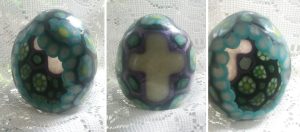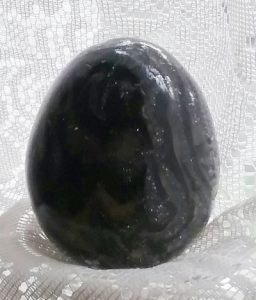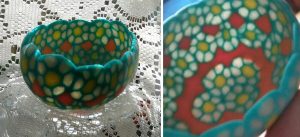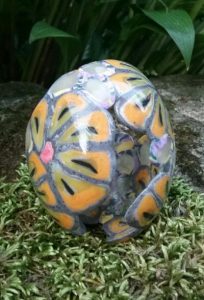I thought when i began this egg that it would be really special, well not so, at least there are about 4 major flaws…as you can see in these photos. The point of the egg was to make translucent stained glass flower look with a cross at the back (inside) of the egg, which i almost pulled off, but not quite. I used the same cane that i had used for the previous blue flower translucent egg, just to test the black fimo as a “leading line” effect for making a stained glass appearance.
- i do wish the translucent premo clay was a little more “translucent” I know there are better clays for this purpose, and have not invested in them to compare. I know that Blue Bottle Tree has done some studies (this woman, if i may say so, is really a scientist, her approach works well for testing) on translucent clay so there are better clays for what i would have liked to achieve out there for me to play with.
- I left a big gouge in the top part of this egg, just careless, and in a hurry, as i always am.
- I should have left more “light” space in the open side of the egg…
- and as usual, a little more sanding would have worked wonders.
- when i soaked out the calcium from the egg shell (took a day, and several refills with vinegar) i also sanded the inside, but I see on the right hand photo there is a little round spot covering a flower where the calcium still persists…. I will chip and sand that away.
- And worst of all, for some reason the side of the egg looks saggy? hmm no clue, as the egg shell over which i built this polymer clay egg certainly did not have a saggy part.
But here are some pix anyway. I never like to give up on a project, and also need the visual reminders of previous mistakes so i am more apt to avoid making them again. Right and left photos are looking into the egg, middle photo is from the back.











